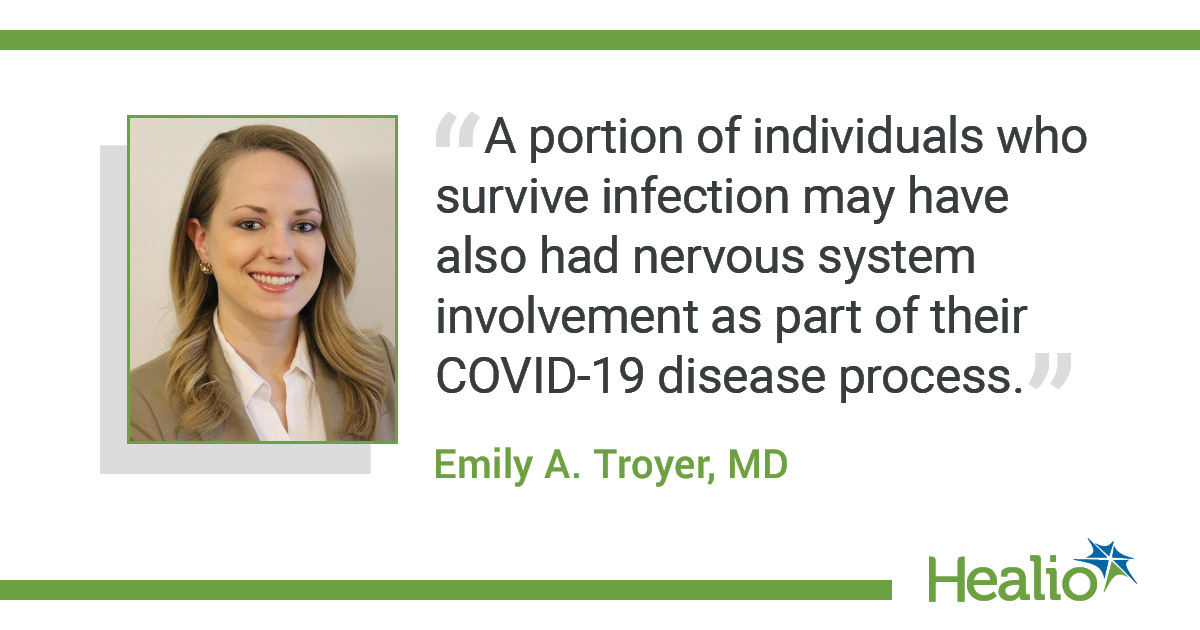COVID-19 survivors may face 'significant neuropsychiatric burden,' experts suggest
Click Here to Manage Email Alerts

Individuals who recover from COVID-19 infection may experience a significant neuropsychiatric burden long after the current pandemic, according to authors of a review article published in Brain, Behavior, and Immunity. Thus, researchers should conduct prospective neuropsychiatric and neuroimmune monitoring of those exposed to SARS-CoV-2 at various points in the life course to better understand the long-term impact of COVID-19, as well as to create a framework for the integration of psychoneuroimmunology into epidemiologic studies of pandemics, the authors noted.
“Clinicians, particularly those in psychiatry, are already seeing the toll the pandemic is taking on public mental health,” Emily A. Troyer, MD, general and child and adolescent psychiatrist in the department of psychiatry at University of California San Diego School of Medicine, told Healio Psychiatry. “Going forward, it might be difficult to discern to what degree an individual's psychiatric symptoms are related to the chronic stress that nearly everyone is experiencing, or to more direct effects of the virus or post-viral inflammation on the nervous system. For patients who have been infected with COVID-19, and particularly those with neurologic symptoms throughout the course of their illness, a multi-disciplinary neurologic and psychiatric approach to treatment will likely be helpful.”
Previous pandemics revealed that diverse types of neuropsychiatric symptoms, including mood changes, psychosis, encephalopathy, neuromuscular dysfunction or demyelinating processes, may accompany acute viral infection or may follow infection by weeks, months or longer among recovered patients. However, the authors noted that many past pandemics of this magnitude occurred tens to hundreds of years ago, and causality and etiopathogenic mechanisms were not clearly identified. Further, in more recent CoV outbreaks, researchers generally have not explored neuropsychiatric symptoms relative to respiratory and other symptoms.
For historical perspective, Troyer and colleagues wrote that influenza pandemics in the 18th and 19th centuries were followed by increased rates of insomnia, anxiety, depression, mania, suicidality and delirium. Outbreaks during the 21st century, such as SARS-CoV-1 in 2003, H1N1 in 2009 and MERS-CoV in 2012, were followed by increased rates of narcolepsy, seizures, encephalitis, Guillain-Barre syndrome and other neuromuscular and demyelinating conditions.

“Reports are already surfacing of acute [central nervous system]-associated symptoms in individuals affected by COVID-19,” review co-author Suzi Hong, PhD, associate professor in the departments of psychiatry and family medicine and public health at University of San Diego School of Medicine, said in a press release.
One such report came via a survey of University of California San Diego Health patients treated for COVID-19, the results of which were published in International Forum of Allergy & Rhinology. This study described the first empirical findings strongly associating sensory loss with COVID-19.
“For the medical community, we need to be mindful of the fact that the coronavirus pandemic may not only take a psychological toll on people generally, but a portion of individuals who survive infection may have also had nervous system involvement as part of their COVID-19 disease process,” Troyer said. “The long-term neuropsychiatric outcomes associated with this are unknown, and we need to design studies to follow survivors over time to monitor for this, and to uncover potential etiopathogenic mechanisms and effective treatments.”
However, Troyer noted that patients who survive COVID-19 infection should not panic about the possibility of long-term neuropsychiatric complications. Thus far, studies have shown that less than half of patients hospitalized for severe COVID-19 have signs of nervous system involvement, and treatments are available for many neuropsychiatric symptoms regardless of their cause.
“With awareness and open discussion, the medical community and public can come together to better understand and mitigate this issue over time,” Troyer said. – by Joe Gramigna
Disclosures: The authors report no relevant financial disclosures.

